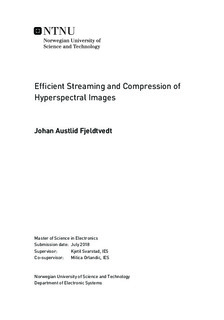| dc.description.abstract | As a part of the SmallSat project at NTNU, a satellite payload capable of capturing and processing of hyperspectral images is being developed. Several processing steps are performed on-board in the satellite, as well as compression of the resulting data to reduce storage needs and to improve utilization of the limited throughput of the radio link to the ground station. As the spatial, spectral and temporal dimensions of hyperspectral images have increased, the need for performing these processing steps in hardware has emerged. FPGA based solutions are attractive due to their reprogrammability and reduced cost compared to dedicated ASICs. In this thesis, two problems related to hyperspectral image processing in FPGA are explored.
The first problem is related to achieving high throughput when data is streamed into and out of hardware processing cores that require streaming in different orders. To achieve high performance, memory accesses must be performed as efficiently as possible for all memory access patterns. Investigating this problem in the feasibility study prior to this thesis work has led to the conclusion that the available direct memory access (DMA) solutions are not suitable. During that work, a new special-purpose DMA core for streaming of hyperspectral images, the \emph{Cube DMA}, was developed. Further developments of this core are presented in this thesis, including improvements in how transfers are performed, implementation of stream to memory channel and addition of stream control signals. The results show an increased throughput of 128\% for block-wise transfers compared to existing DMA solutions, while FPGA resource utilization is lower.
The other problem that has been explored is compression of image data in the satellite. CCSDS123 is a compression algorithm designed for hyperspectral images. An efficient and parallelized hardware implementation of this algorithm has been designed, implemented and thoroughly verified. The results show that its performance is better than any state of the art implementations in terms of achievable data throughput, while showing modest power usage and resource utilization. | |

